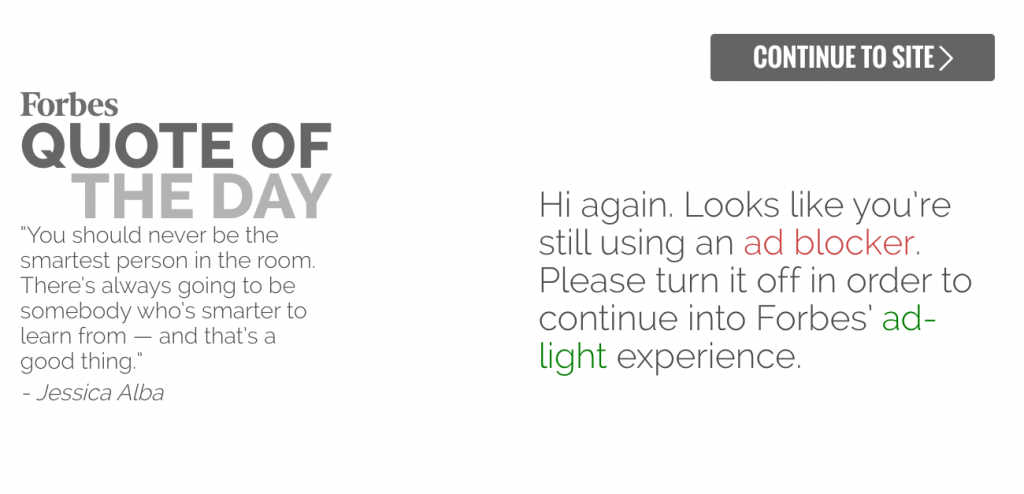 By Laura Petrolino
By Laura Petrolino
I actually started out to write a very personal “life lessons” post about birthdays (because Lubna Sadik asked for a birthday analogy post and I have to encourage her so she continues to encourage me). But as I went to check out an article on Forbes pertaining to my post, I was stopped.
Not just with the usual, annoying Forbes quote landing page, but totally stopped, with this:

The Stats Around Ad Blocking
That led me to think about ad blocking and investigate how big of a problem it might be (obviously big for Forbes—who can charge advertisers large amounts—to gate their content in an attempt to protect their advertising dollars).
I found a 2015 report from PageFair, which outlined some stats that probably make the advertising and publishing world a bit queasy:
- Ad blocking was estimated to cost publishers nearly $22 billion during 2015.
- There are 198 million active ad block users around the world.
- Ad blocking grew by 41 percent globally in the 12 months prior to the report.
- Specifically, U.S. ad blocking grew by 48 percent to reach 45 million active users (as of June 2015).
Likewise, a study by Sourcepoint and comScore showed ad blocking is most popular among younger audiences and high earners—so the audiences advertisers are most likely to want to reach (and those publishers can charge the most to help them reach).
And while these studies focused on desktop ad blocking, mobile is also on the rise.
So what’s a publisher to do?
- People don’t want to pay for content (the 2015 Reuters Institute Digital News Report found around 11 percent of people pay for digital content).
- And they don’t want ads that pay for the content.
- Content likes, shares, comments, and admiration don’t necessarily put food on the table for publishers or their staff.
The Results of Forbes Ad-Blocking Experiment
Forbes launched their content blocking experiment December 17th, and after a month in action Lewis Vorkin, chief product officer, wrote a fascinating recap of the results, to date.
- Forty-four percent of their test pool—1.6 million visitors— turned off ad blockers or white listed Forbes content and ads.
- The number of viewable ads on pages consumed by those who turned off their blockers is 9.3 percent more than the sitewide average for those who never used blockers.
- The time spent on page, by those who turned off their blockers was twice the amount of non-ad block users—three minutes.
- The clickthrough rate on ads by those turning off ad blockers remained above the industry average.
- Forbes delivered 29 million new ad impressions between December 17 and January 14.
Why We Block Ads
Lewis also curated the feedback they had received since the start to the test into a seven point checklist of why people use ad blockers:
- Ad Clutter: Flashing, jumping, in-your-face ads, video pre-rolls, and other ad techniques used to disturb the user experience.
- Ad Networks: They frequently stalk users across the web, and often carry malicious software.
- Privacy and Security: As Lewis points out, “There are many unscrupulous players out there who try to work the seams of ad networks.” Add in cookies and other trackers that collect our information and know the name of our first born child (before we have it) and it’s pretty scary.
- Bandwidth: Many ads slow down load speed or lock-up bandwidth so much they make web surfing or even scrolling down the page impossible, again destroying the user experience.
- Generational: As many other studies have shown, the new consumer was born and raised on free content. They expect it and demand it.
- Transparency: People want to control their own privacy, so not knowing what information is collected on them as they surf the web is troubling.
- Content Trends: TL;DR trends encourage content that’s short and concise. But when you take a 500 word story and jam it with the same number of ads as a 1,500 word story….it doesn’t translate well.
What the Future Holds
When you look at the majority of above points they can be summarized in user experience and privacy.
Now the privacy issue is a completely different beast altogether, but we see the quest to improve user experience played out in the smart and strategic use of brand journalism, native advertising, and sponsored content.
I remember Gini Dietrich first talking about the rise of native advertising in 2013 and wondering how it would play out.
Since then we’ve seen an increasing amount of examples of this tactic used really well to blur the lines between content marketing and advertising, and it’s something we look at often when building out the paid media side of client strategies because the many creative and extremely targeted ways in can play out.
Forbes uses native advertising in their BrandVoice program, other major publishing outlets also integrate it exceptionally well into an overall branded newsroom—which uses the PESO model for creation and distribution—and includes both organic and sponsored content.
The secret is all the content provides value to the reader—even if the advertiser beyond the post itself isn’t of interest or value. This creates a completely different dynamic and removes problems with advertising destroying user experience—if it is done well.
It is trends like these that publishers and advertisers must look to as they move forward.
Content-based, creative, informative, useful—while not as easy as throwing up an ad page, the ever-evolving, demanding, and digitally savvy consumer is forcing marketers to create integrated and high quality campaigns to remain relevant and successful.